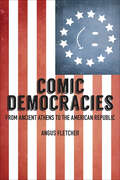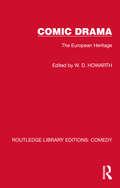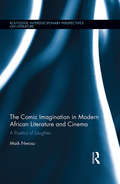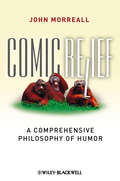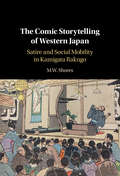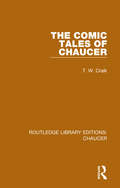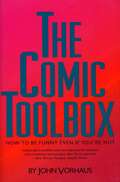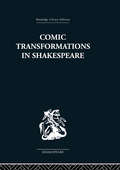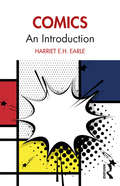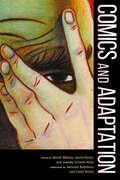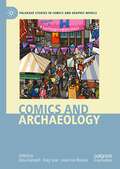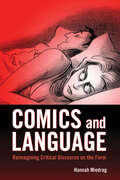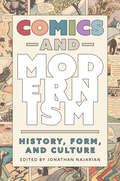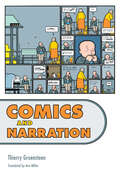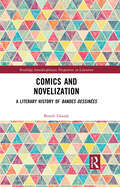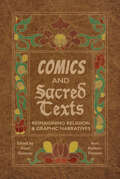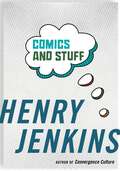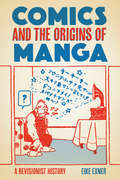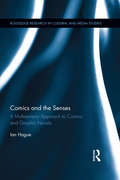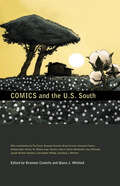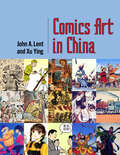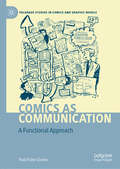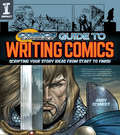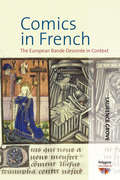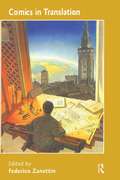- Table View
- List View
Comic Democracies: From Ancient Athens to the American Republic
by Angus Fletcher“Invites its readers to note the leaders and people who are willing and able to laugh, with and at themselves . . . Our political life may depend upon it.” —The Review of PoliticsFor two thousand years, democratic authors treated comedy as a toolkit of rhetorical practices for encouraging problem-solving, pluralism, risk-taking, and other civic behaviors that increased minority participation in government. Over the past two centuries, this pragmatic approach to extending the franchise has been displaced by more idealistic democratic philosophies that focus instead on promoting liberal principles and human rights. But in the wake of the recent “democracy recession” in the Middle East, the Third World, and the West itself, there has been renewed interest in finding practical sources of popular rule. Comic Democracies joins in the search by exploring the value of the old comic tools for growing democracy today.Drawing on new empirical research from the political and cognitive sciences, Angus Fletcher deftly analyzes the narrative elements of two dozen stage plays, novels, romances, histories, and operas written by such authors as Aristophanes, Menander, Plautus, Ariosto, Machiavelli, Cervantes, Shakespeare, Ben Jonson, William Congreve, John Gay, Henry Fielding, and Washington Irving. He unearths five comic techniques used to foster democratic behaviors in antiquity and the Renaissance, then traces the role of these techniques in Tom Paine’s Common Sense, Jefferson’s preamble to the Declaration of Independence, Washington’s farewell address, Mercy Otis Warren’s federalist history of the Revolution, Frederick Douglass’s abolitionist orations, and other documents that played a pivotal role in the development of the American Republic.After recovering these lost chapters of our democratic past, Comic Democracies concludes with a draft for the future, using the old methods of comedy to envision a modern democracy—rooted in the diversity, ingenuity, and power of popular art.“Fletcher’s main theory is convincing and will open up new fields of inquiry. This accessible work is for those interested in political science, cultural history, and comic theory as well as classical literature.” —Choice
Comic Drama: The European Heritage (Routledge Library Editions: Comedy)
by W. D. HowarthEver since comedies were first performed in the ancient world, the definition of the term ‘comedy’ has been debated by both playwrights and critics. Originally published in 1978, this volume does not attempt a precise definition, but reviews the various interpretations that have been put forward through the ages, taking as evidence important theoretical writings as well as the plays themselves, and pointing out not only common features but also notable exceptions. The comic drama of Western Europe since the Renaissance is here surveyed in a series of chapters devoted principally to the tradition of European comedy as it developed in the major national literatures. The perspective is expanded to include, on the one hand, the origins in classical Greece and Rome and, on the other, the influence of cinema, radio and television comedy at the time – American as well as European. A structural basis for the volume as a whole is provided in an analytical introduction, where the essential problems are defined: such issues as the relationship between comedy and satire, comedy and farce; the distinction between laughter and smile; the respective claims of realism and fantasy; the role of plot and of dialogue; the place of sentiment and of moral teaching; and the possibility of comic catharsis. In this way the nature and evolution of European comedy is presented in an original and coherent form, not only offering an invaluable aid to students seeking guidance in literature of which they are not making a specialist study, but stimulating the more experienced reader to think again about familiar plays.
The Comic Imagination in Modern African Literature and Cinema: A Poetics of Laughter (Routledge Interdisciplinary Perspectives on Literature)
by Maik NwosuThis book is a seminal study that significantly expands the interdisciplinary discourse on African literature and cinema by exploring Africa’s under-visited carnivalesque poetics of laughter. Focusing on modern African literature as well as contemporary African cinema, particularly the direct-to-video Nigerian film industry known as Nollywood, the book examines the often-neglected aesthetics of the African comic imagination. In modern African literature, which sometimes creatively traces a path back to African folklore, and in Nollywood — with its aesthetic relationship to Onitsha Market Literature — the pertinent styles range from comic simplicitas to comic magnitude with the facilitation of language, characterization, and plot by a poetics of laughter or lightness as an important aspect of style. The poetics at work is substantially carnivalesque, a comic preference or tendency that is attributable, in different contexts, to a purposeful comic sensibility or an unstructured but ingrained or virtual comic mode. In the best instances of this comic vision, the characteristic laughter or lightness can facilitate a revaluation or reappreciation of the world, either because of the aesthetic structure of signification or the consequent chain of signification. This referentiality or progressive signification is an important aspect of the poetics of laughter as the African comic imagination variously reflects, across genres, both the festival character of comedy and its pedagogical value. This book marks an important contribution to African literature, postcolonial literature, world literature, comic imagination, poetics, critical theory, and African cinema.
Comic Relief
by John MorreallComic Relief: A Comprehensive Philosophy of Humor develops an inclusive theory that integrates psychological, aesthetic, and ethical issues relating to humor Offers an enlightening and accessible foray into the serious business of humorReveals how standard theories of humor fail to explain its true nature and actually support traditional prejudices against humor as being antisocial, irrational, and foolishArgues that humor's benefits overlap significantly with those of philosophyIncludes a foreword by Robert Mankoff, Cartoon Editor of The New Yorker
The Comic Storytelling of Western Japan: Satire and Social Mobility in Kamigata Rakugo
by M. W. ShoresRakugo, a popular form of comic storytelling, has played a major role in Japanese culture and society. Developed during the Edo (1600–1868) and Meiji (1868–1912) periods, it is still popular today, with many contemporary Japanese comedians having originally trained as rakugo artists. Rakugo is divided into two distinct strands, the Tokyo tradition and the Osaka tradition, with the latter having previously been largely overlooked. This pioneering study of the Kamigata (Osaka) rakugo tradition presents the first complete English translation of five classic rakugo stories, and offers a history of comic storytelling in Kamigata (modern Kansai, Kinki) from the seventeenth century to the present day. Considering the art in terms of gender, literature, performance, and society, this volume grounds Kamigata rakugo in its distinct cultural context and sheds light on the 'other' rakugo for students and scholars of Japanese culture and history.
The Comic Tales of Chaucer (Routledge Library Editions: Chaucer)
by T. W. CraikOriginally published in 1964. This book deals wholly with Chaucer’s comic tales. The individual tales are not discussed in isolation but always with reference to the others and to Chaucer’s poetry as a whole. By this comparison and analysis, this book illuminates the features of Chaucer’s many-sided art.
The Comic Toolbox: How To Be Funny Even If You're Not
by John VorhausA workbook approach to comedy writing as creative problem-solving. It offers tools of the trade such as Clash of Context, Tension and Release, The Law of Comic Opposites, The Wildly Inappropriate Response, and The Myth of the Last Great Idea to writers, comics, and anyone else who wants to be funny.
Comic Transformations in Shakespeare
by Ruth NevoFirst published in 1980. In this study of Shakespeare's ten early comedies, from The Comedy of Errors to Twelfth Night, the concept of a dynamic of comic form is developed; the Falstaff plays are seen as a watershed, and the emergence of new comic protagonists - the resourceful, anti-romantic romantic heroine and the Fool - as the summit of the achievement. The plays are explored from three complementary perspectives - theoretical, developmental and interpretative which lead to a further understanding of the powerful relation between the plays' formal complexity and their naturalistic verisimilitude.
Comics: An Introduction
by Harriet E.H. EarleComics: An Introduction provides a clear and detailed introduction to the Comics form – including graphic narratives and a range of other genres – explaining key terms, history, theories, and major themes. The book uses a variety of examples to show the rich history as well as the current cultural relevance and significance of Comics. Taking a broadly global approach, Harriet Earle discusses the history and development of the form internationally, as well as how to navigate comics as a new way of reading. Earle also pushes beyond the book to lay out the ways that fans engage with their comics of choice – and how this can impact the industry. She also analyses how Comics can work for social change and political comment. Discussing journalism and life writing, she examines how the coming together of word and image gives us new ways to discuss our world and ourselves. A glossary and further reading section help those new to Comics solidify their understanding and further their exploration of this dynamic and growing field.
Comics and Adaptation
by Benoît Mitaine, David Roche and Isabelle Schmitt-PitiotContributions by Jan Baetens, Alain Boillat, Philippe Bourdier, Laura Cecilia Caraballo, Thomas Faye, Pierre Floquet, Jean-Paul Gabilliet, Christophe Gelly, Nicolas Labarre, Benoît Mitaine, David Roche, Isabelle Schmitt-Pitiot, Dick Tomasovic, and Shannon Wells-LassagneBoth comics studies and adaptation studies have grown separately over the past twenty years. Yet there are few in-depth studies of comic books and adaptations together. Available for the first time in English, this collection pores over the phenomenon of comic books and adaptation, sifting through comics as both sources and results of adaptation. Essays shed light on the many ways adaptation studies inform research on comic books and content adapted from them. Contributors concentrate on fidelity to the source materials, comparative analysis, forms of media, adaptation and myth, adaptation and intertextuality, as well as adaptation and ideology.After an introduction that assesses adaptation studies as a framework, the book examines comics adaptations of literary texts as more than just illustrations of their sources. Essayists then focus on adaptations of comics, often from a transmedia perspective. Case studies analyze both famous and lesser-known American, Belgian, French, Italian, and Spanish comics.Essays investigate specific works, such as Robert Louis Stevenson's The Strange Case of Dr. Jekyll and Mr. Hyde, the Castilian epic poem Poema de Mio Cid, Ray Bradbury's Martian Chronicles, French comics artist Jacques Tardi's adaptation 120, rue de la Gare, and Frank Miller's Sin City. In addition to Marvel Comics' blockbusters, topics include various uses of adaptation, comic book adaptations of literary texts, narrative deconstruction of performance and comic book art, and many more.
Comics and Archaeology (Palgrave Studies in Comics and Graphic Novels)
by Zena Kamash Katy Soar Leen Van BroeckThis book adds to the scant academic literature investigating how comics transmit knowledge of the past and how this refraction of the past shapes our understanding of society and politics in sometimes damaging ways. The volume comes at these questions from a specifically archaeological perspective, foregrounding the representation and narrative use of material cultures. It fulfils its objectives through three reception studies in the first part of the volume and three chapters by comic creators in the second part. All six chapters aim to grapple with a set of central questions about the power inherent in drawn images of various kinds.
Comics and Language: Reimagining Critical Discourse on the Form
by Hannah MiodragIt has become an axiom in comic studies that "comics is a language, not a genre." But what exactly does that mean, and how is discourse on the form both aided and hindered by thinking of it in linguistic terms? In Comics and Language, Hannah Miodrag challenges many of the key assumptions about the "grammar" and formal characteristics of comics, and offers a more nuanced, theoretical framework that she argues will better serve the field by offering a consistent means for communicating critical theory in the scholarship. Through engaging close readings and an accessible use of theory, this book exposes the problems embedded in the ways critics have used ideas of language, literature, structuralism, and semiotics, and sets out a new and more theoretically sound way of understanding how comics communicate. Comics and Language argues against the critical tendency to flatten the distinctions between language and images and to discuss literature purely in terms of story content. It closely examines the original critical theories that such arguments purport to draw on and shows how they in fact point away from the conclusions they are commonly used to prove. The book improves the use the field makes of existing scholarly disciplines and furthers the ongoing sophistication of the field. It provides animated and insightful analyses of a range of different texts and takes an interdisciplinary approach. Comics and Language will appeal to the general comics reader and will prove crucial for specialized scholars in the fields of comics, literature, cultural studies, art history, and visual studies. It also provides a valuable summary of the current state of formalist criticism within comics studies and so presents the ideal text for those interested in exploring this growing area of research
Comics and Modernism: History, Form, and Culture (Tom Inge Series on Comics Artists)
by Jonathan NajarianContributions by David M. Ball, Scott Bukatman, Hillary Chute, Jean Lee Cole, Louise Kane, Matthew Levay, Andrei Molotiu, Jonathan Najarian, Katherine Roeder, Noa Saunders, Clémence Sfadj, Nick Sturm, Glenn Willmott, and Daniel Worden Since the early 1990s, cartoonist Art Spiegelman has made the case that comics are the natural inheritor of the aesthetic tradition associated with the modernist movement of the early twentieth century. In recent years, scholars have begun to place greater import on the shared historical circumstances of early comics and literary and artistic modernism. Comics and Modernism: History, Form, and Culture is an interdisciplinary consideration of myriad social, cultural, and aesthetic connections. Filling a gap in current scholarship, an impressively diverse group of scholars approaches the topic from a variety of disciplinary backgrounds and methodologies. Drawing on work in literary studies, art history, film studies, philosophy, and material culture studies, contributors attend to the dynamic relationship between avant-garde art, literature, and comics. Essays by both established and emerging voices examine topics as divergent as early twentieth-century film, museum exhibitions, newspaper journalism, magazine illustration, and transnational literary circulation. In presenting varied critical approaches, this book highlights important interpretive questions for the field. Contributors sometimes arrive at thoughtful consensus and at other times settle on productive disagreements. Ultimately, this collection aims to extend traditional lines of inquiry in both comics studies and modernist studies and to reveal overlaps between ostensibly disparate artistic practices and movements.
Comics and Narration
by Thierry GroensteenThis book is the follow-up to Thierry Groensteen's groundbreaking The System of Comics, in which the leading French-language comics theorist set out to investigate how the medium functions, introducing the principle of iconic solidarity, and showing the systems that underlie the articulation between panels at three levels: page layout, linear sequence, and nonsequential links woven through the comic book as a whole. He now develops that analysis further, using examples from a very wide range of comics, including the work of American artists such as Chris Ware and Robert Crumb. He tests out his theoretical framework by bringing it up against cases that challenge it, such as abstract comics, digital comics and shojo manga, and offers insightful reflections on these innovations. In addition, he includes lengthy chapters on three areas not covered in the first book. First, he explores the role of the narrator, both verbal and visual, and the particular issues that arise out of narration in autobiographical comics. Second, Groensteen tackles the question of rhythm in comics, and the skill demonstrated by virtuoso artists in intertwining different rhythms over and above the basic beat provided by the discontinuity of the panels. And third he resets the relationship of comics to contemporary art, conditioned by cultural history and aesthetic traditions but evolving recently as comics artists move onto avant-garde terrain.
Comics and Novelization: A Literary History of Bandes Dessinées (Routledge Interdisciplinary Perspectives on Literature)
by Benoît GlaudeThis book opens a novel perspective on comics and literature interactions. It claims that the two artistic media have always maintained a mutual emulation, for as long as they have coexisted in media culture. To demonstrate this, the present research does not focus on literary adaptations in comics form but rather on a literary corpus that remains virtually unexplored: comics-related novels. The purpose of this volume is to inventory French comics-related novels and to study them. Within the limits of the French-speaking world, this book pieces together a literary history of bande dessinée through its novels, from the nineteenth to twenty-first centuries. Although the comic strip – including the aptly named "graphic novel" – has sometimes been regarded as the disciple of an unsurpassable literary model, do these under-studied adaptations in novel form not rather indicate a mutual relationship, or even an emulation, between the two media?
Comics and Sacred Texts: Reimagining Religion and Graphic Narratives
by Assaf Gamzou and Ken Koltun-FrommContributions by Ofra Amihay, Madeline Backus, Samantha Baskind, Elizabeth Rae Coody, Scott S. Elliott, Assaf Gamzou, Susan Handelman, Leah Hochman, Leonard V. Kaplan, Ken Koltun-Fromm, Shiamin Kwa, Samantha Langsdale, A. David Lewis, Karline McLain, Ranen Omer-Sherman, Joshua Plencner, and Jeffrey L. RicheyComics and Sacred Texts explores how comics and notions of the sacred interweave new modes of seeing and understanding the sacral. Comics and graphic narratives help readers see religion in the everyday and in depictions of God, in transfigured, heroic selves as much as in the lives of saints and the meters of holy languages. Coeditors Assaf Gamzou and Ken Koltun-Fromm reveal the graphic character of sacred narratives, imagining new vistas for both comics and religious texts. In both visual and linguistic forms, graphic narratives reveal representational strategies to encounter the sacred in all its ambivalence. Through close readings and critical inquiry, these essays contemplate the intersections between religion and comics in ways that critically expand our ability to think about religious landscapes, rhetorical practices, pictorial representation, and the everyday experiences of the uncanny. Organized into four sections—Seeing the Sacred in Comics; Reimagining Sacred Texts through Comics; Transfigured Comic Selves, Monsters, and the Body; and The Everyday Sacred in Comics—the essays explore comics and graphic novels ranging from Craig Thompson’s Habibi and Marvel’s X-Men and Captain America to graphic adaptions of religious texts such as 1 Samuel and the Gospel of Mark.Comics and Sacred Texts shows how claims to the sacred are nourished and concealed in comic narratives. Covering many religions, not only Christianity and Judaism, this rare volume contests the profane/sacred divide and establishes the import of comics and graphic narratives in disclosing the presence of the sacred in everyday human experience.
Comics and Stuff
by Henry JenkinsConsiders how comics display our everyday stuff—junk drawers, bookshelves, attics—as a way into understanding how we represent ourselves nowFor most of their history, comics were widely understood as disposable—you read them and discarded them, and the pulp paper they were printed on decomposed over time. Today, comic books have been rebranded as graphic novels—clothbound high-gloss volumes that can be purchased in bookstores, checked out of libraries, and displayed proudly on bookshelves. They are reviewed by serious critics and studied in university classrooms. A medium once considered trash has been transformed into a respectable, if not elite, genre.While the American comics of the past were about hyperbolic battles between good and evil, most of today’s graphic novels focus on everyday personal experiences. Contemporary culture is awash with stuff. They give vivid expression to a culture preoccupied with the processes of circulation and appraisal, accumulation and possession. By design, comics encourage the reader to scan the landscape, to pay attention to the physical objects that fill our lives and constitute our familiar surroundings. Because comics take place in a completely fabricated world, everything is there intentionally. Comics are stuff; comics tell stories about stuff; and they display stuff.When we use the phrase “and stuff” in everyday speech, we often mean something vague, something like “etcetera.” In this book, stuff refers not only to physical objects, but also to the emotions, sentimental attachments, and nostalgic longings that we express—or hold at bay—through our relationships with stuff.In Comics and Stuff, his first solo authored book in over a decade, pioneering media scholar Henry Jenkins moves through anthropology, material culture, literary criticism, and art history to resituate comics in the cultural landscape. Through over one hundred full-color illustrations, using close readings of contemporary graphic novels, Jenkins explores how comics depict stuff and exposes the central role that stuff plays in how we curate our identities, sustain memory, and make meaning. Comics and Stuff presents an innovative new way of thinking about comics and graphic novels that will change how we think about our stuff and ourselves.
Comics and the Origins of Manga: A Revisionist History
by Eike ExnerComics and the Origins of Manga challenges the conventional wisdom that manga evolved from traditional Japanese art, and reveals how Japanese cartoonists in the 1920s and 1930s instead developed modern manga out of translations of foreign comic strips like Bringing Up Father, Happy Hooligan, and Felix the Cat.
Comics and the Senses: A Multisensory Approach to Comics and Graphic Novels (Routledge Research in Cultural and Media Studies)
by Ian HagueAttempts to define what comics are and explain how they work have not always been successful because they are premised upon the idea that comic strips, comic books and graphic novels are inherently and almost exclusively visual. This book challenges that premise, and asserts that comics is not just a visual medium. The book outlines the multisensory aspects of comics: the visual, audible, tactile, olfactory and gustatory elements of the medium. It rejects a synaesthetic approach (by which all the senses are engaged through visual stimuli) and instead argues for a truly multisensory model by which the direct stimulation of the reader’s physical senses can be understood. A wide range of examples demonstrates how multisensory communication systems work in both commercial and more experimental contexts. The book concludes with a case study that looks at the works of Alan Moore and indicates areas of interest that multisensory analysis can draw out, but which are overlooked by more conventional approaches.
Comics and the U.S. South
by Brannon CostelloComics and the U.S. South offers a wide-ranging and long overdue assessment of how life and culture in the United States South is represented in serial comics, graphic novels, newspaper comic strips, and webcomics. Diverting the lens of comics studies from the skyscrapers of Superman's Metropolis or Chris Ware's Chicago to the swamps, backroads, small towns, and cities of the U.S. South, this collection critically examines the pulp genres associated with mainstream comic books alongside independent and alternative comics.Some essays seek to discover what Captain America can reveal about southern regionalism and how slave narratives can help us reread Swamp Thing; others examine how creators such as Walt Kelly (Pogo), Howard Cruse (Stuck Rubber Baby), Kyle Baker (Nat Turner), and Josh Neufeld (A.D.: New Orleans after the Deluge) draw upon the unique formal properties of the comics to question and revise familiar narratives of race, class, and sexuality; and another considers how southern writer Randall Kenan adapted elements of comics form to prose fiction. With essays from an interdisciplinary group of scholars, Comics and the U.S. South contributes to and also productively reorients the most significant and compelling conversations in both comics scholarship and in southern studies.
Comics Art in China
by John A. Lent Ying XuInternational Convention of Asia Scholars 2019 Book Prize – Best Art PublicationIn the most comprehensive and authoritative source on this subject, Comics Art in China covers almost all comics art forms in mainland China, providing the history from the nineteenth century to the present as well as perspectives on both the industry and the art form. This volume encompasses political, social, and gag cartoons, lianhuanhua (picture books), comic books, humorous drawings, cartoon and humor periodicals, and donghua (animation) while exploring topics ranging from the earliest Western-influenced cartoons and the popular, often salacious, 1930s humor magazines to cartoons as wartime propaganda and comics art in the reform. Coupling a comprehensive review of secondary materials (histories, anthologies, biographies, memoirs, and more) in English and Chinese with the artists’ actual works, the result spans more than two centuries of Chinese animation. Structured chronologically, the study begins with precursors in early China and proceeds through the Republican, wartime, Communist, and market economy periods. Based primarily on interviews senior scholar John A. Lent and Xu Ying conducted with over one hundred cartoonists, animators, and other comics art figures, Comics Art in China sheds light on tumult and triumphs. Meticulously, Lent and Xu describe the evolution of Chinese comics within a global context, probing the often-tense relationship between expression and government, as well as proving that art can be a powerful force for revolution. Indeed, the authors explore Chinese comics art as it continues to grow and adapt in the twenty-first century. Enhanced with over one hundred black-and-white and color illustrations, this book stands out as not only the first such survey in English, but perhaps the most complete one in any language.
Comics as Communication: A Functional Approach (Palgrave Studies in Comics and Graphic Novels)
by Paul Fisher DaviesThis book explores how comics function to make meanings in the manner of a language. It outlines a framework for describing the resources and practices of comics creation and readership, using an approach that is compatible with similar descriptions of linguistic and multimodal communication. The approach is based largely on the work of Michael Halliday, drawing also on the pragmatics of Paul Grice, the Text World Theory of Paul Werth and Joanna Gavins, and ideas from art theory, psychology and narratology. This brings a broad Hallidayan framework of multimodal analysis to comics scholarship, and plays a part in extending that tradition of multimodal linguistics to graphic narrative.
Comics Experience Guide to Writing Comics: Scripting Your Story Ideas from Start to Finish
by Andy SchmidtUnlock the secrets to comic-writing success! "You have a story tell. It's your story... These are ways to help you get your story out, to help you become the writer inside of yourself." This is the book on writing you've been waiting for, a nuts-and-bolts guide to writing fiction for comics. While it is true that there is no set way to write a comic book script, no set format, no industry standard, it is equally true that someone learning to write comics needs structure. That's where Comics Experience© Guide to Writing Comics can help. Comics veteran Andy Schmidt offers sage advice and practical instruction for everything from writing realistic dialogue to communicating your ideas to other comics professionals. Inside you'll find:23 exercises to help you put fundamental writing principles into practiceSample script formats, page-by-page outlines, scene-by-scene outlines and short pitches that show you exactly how to create these important components of the writing processDiagrams and pages from published comics to illustrate key conceptsTips on professional development, networking and navigating the comics industryThese pages include all the tools you need to write great comics, but where do you begin? Begin with yourself. You have to know--not believe--know: You can do this, and this guide will help. Now, begin with Chapter 1...
Comics In French
by Laurence GroveWhereas in English-speaking countries comics are for children or adults 'who should know better', in France and Belgium the form is recognized as the 'Ninth Art' and follows in the path of poetry, architecture, painting and cinema. The bande dessinée [comic strip] has its own national institutions, regularly obtains front-page coverage and has received the accolades of statesmen from De Gaulle onwards. On the way to providing a comprehensive introduction to the most francophone of cultural phenomena, this book considers national specificity as relevant to an anglophone reader, whilst exploring related issues such as text/image expression, historical precedents and sociological implication. To do so it presents and analyses priceless manuscripts, a Franco- American rodent, Nazi propaganda, a museum-piece urinal, intellectual gay porn and a prehistoric warrior who's really Zinedine Zidane.
Comics in Translation
by Federico ZanettinComics are a pervasive art form and an intrinsic part of the cultural fabric of most countries. And yet, relatively little has been written on the translation of comics. Comics in Translation attempts to address this gap in the literature and to offer the first and most comprehensive account of various aspects of a diverse range of social practices subsumed under the label 'comics'. Focusing on the role played by translation in shaping graphic narratives that appear in various formats, different contributors examine various aspects of this popular phenomenon. Topics covered include the impact of globalization and localization processes on the ways in which translated comics are embedded in cultures; the import of editorial and publishing practices; textual strategies adopted in translating comics, including the translation of culture- and language-specific features; and the interplay between visual and verbal messages. Comics in translation examines comics that originate in different cultures, belong to quite different genres, and are aimed at readers of different age groups and cultural backgrounds, from Disney comics to Art Spiegelman's Maus, from Katsuhiro Ōtomo's Akira to Goscinny and Uderzo's Astérix. The contributions are based on first-hand research and exemplify a wide range of approaches. Languages covered include English, Italian, Spanish, Arabic, French, German, Japanese and Inuit. The volume features illustrations from the works discussed and an extensive annotated bibliography. Contributors include: Raffaella Baccolini, Nadine Celotti, Adele D'Arcangelo, Catherine Delesse, Elena Di Giovanni, Heike Elisabeth Jüngst, Valerio Rota, Carmen Valero-Garcés, Federico Zanettin and Jehan Zitawi.
